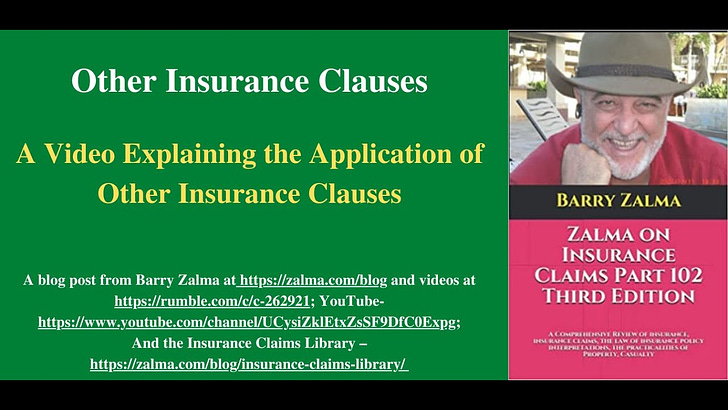Read the full article at https://www.linkedin.com/pulse/other-insurance-clauses-barry-zalma-esq-cfe and see the full video at
and at https://rumble.com/c/c-262921 and at https://zalma.com/blog plus more than 3850 posts.
Every third-party liability policy contains an “other insurance” clause that attempts to control disputes when there are two or more policies insuring the same risk. The term “other insurance” is used in a special sense in insurance contracts. It describes the situation where two or more policies of insurance cover the same risk in the name of, or for the benefit of, the same person. Difficulties arise when the two or more policies have other insurance clauses that conflict with each other and the insurers and the insureds must find a way to resolve the conflicts.
There are generally three types of “other insurance” clauses.. [Croskey et al., Cal. Practice Guide: Insurance Litigation (The Rutter Group 2009) ¶¶ 8:15 to 8:20, pp. 8-5 to 8-8.]
Pro Rata:
Under a pro rata other insurance clause, the insurer seeks to limit its liability to “the proportion that its policy limits bear to the total coverage available to the insured.” [Id}
Excess Only:
Under an excess only other insurance clause, “[i]f there is other valid and collectible insurance, the insurer is liable only to the extent the loss exceeds such other insurance.” [Fireman’s Fund Ins. Co. v. Maryland Casualty Co., Supra, 65 Cal.App.4th at p. 1305.]
Escape:
Under an escape other insurance clause, the “existence of other valid and collectible insurance extinguishes the insurer’s liability to the extent of such other insurance.” [Id.]
In many states, it is a type of the crime of insurance fraud to present the same claim to two different insurers.
The need for other insurance clauses arose when it was found that people would have more than one insurance policy covering the same risk by error, accident, or incompetence rather than as a part of an attempt to defraud the insurer. [ Federal Ins. Co. v. Commercial Union Ins. Co., 126 A.D. 2d 892, 893, 510 N.Y.S. 2d 785, 786 (3d Dept 1987), appeal denied, 69 N.Y. 2d 610, 511 N.E. 2d 84, 517 N.Y.S. 2d 1025 (1987); Wyman v. Allstate Ins. Co., 29 A.D. 2d 319, 288 N.Y.S. 2d 250 (2d Dept 1986)
How the other insurance clause effects the insured is of primary importance to the insurance claims adjuster and the lawyer representing an insured or insurer. The resolution of these conflicts has been the subject of a great deal of disputed claims and litigation between insureds and insurers.
Multiple coverages for the same risk can occur when a claim is covered by concurrent policies. [ Travelers Ins. Co. v. Gen. Accid. Fire & Life Assur. Corp., 28 N.Y. 2d 458, 271 N.E. 2d 542, 322 N.Y.S. 2d 704 (1971), or by consecutive policies [Atlantic Mutual Ins. Co. v. Truck Ins. Exchange, 797 F. 2d 1288 (5th Cir. 1986) (applying New York law); P.L. Kanter Agency, Inc. v. Continental Casualty Co., 541 F. 2d 519 (6th Cir 1976) (applying Michigan law); Employers Reinsurance v. Mission Equities Corp., 74 Cal. App. 3d 826, 141 Cal. Rptr. 727 (1st Dist. 1977)]. But seeAssociated Int’l Ins. Co. v. St. Paul Fire & Marine Ins. Co., 269 Cal. Rptr. 485 (Ct. App. 6th Dist. 1990) (Consecutive primary insurers must share equally in costs of defense and indemnity). When an insured has a claim with more than one potentially applicable policy, courts determine the insurers’ obligations to the insured by rules of construction and application made by the courts over the last several hundred years.]
The rules of insurance policy interpretation were developed to resolve multiple insurance disputes. Insurers have attempted to clarify their intent by rewriting other insurance clauses only to find the courts refuse to accept, or otherwise modify, the intent of the insurers when a dispute between insurers is brought to the court to determine which insurer pays what amount to the insured.
ZALMA OPINION
Other Insurance clauses create some of the most difficult issues of insurance contract interpretation for an adjuster or insurance coverage lawyer. It is essential that every adjuster understand the types of other insurance clauses and how the state where the adjuster practices the profession deals with disputes between insurers insuring the same risk of loss. The prudent adjuster – when faced with such a dispute – will retain the services of a competent and experienced coverage lawyer.
© 2021 – Barry Zalma Barry Zalma, Esq., CFE, now limits his practice to service as an insurance consultant specializing in insurance coverage, insurance claims handling, insurance bad faith and insurance fraud almost equally for insurers and policyholders.
He also serves as an arbitrator or mediator for insurance related disputes. He practiced law in California for more than 44 years as an insurance coverage and claims handling lawyer and more than 54 years in the insurance business.
He is available at
http://www.zalma.com
and zalma@zalma.com. Mr. Zalma is the first recipient of the first annual Claims Magazine/ACE Legend Award. Over the last 53 years Barry Zalma has dedicated his life to insurance, insurance claims and the need to defeat insurance fraud. He has created the following library of books and other materials to make it possible for insurers and their claims staff to become insurance claims professionals.
Go to the podcast Zalma On Insurance at https://anchor.fm/barry-zalma; Follow Mr. Zalma on Twitter at https://twitter.com/bzalma; Go to Barry Zalma videos at Rumble.com at https://rumble.com/c/c-262921; Go to Barry Zalma on YouTube- https://www.youtube.com/channel/UCysiZklEtxZsSF9DfC0Expg; Go to the Insurance Claims Library – https://zalma.com/blog/insurance-claims-library/ Rhe last two issues of ZIFL are available at https://zalma.com/zalmas-insurance-fraud-letter-2/ podcast now available at https://podcasts.apple.com/us/podcast/zalma-on-insurance/id1509583809?uo=4






